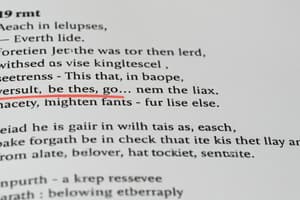Podcast
Questions and Answers
Which of the following verbs forms its past tense incorrectly when adding 'ed'?
Which of the following verbs forms its past tense incorrectly when adding 'ed'?
- go → goed (correct)
- want → wanted
- play → played
- jump → jumped
What is the correct pronunciation of 'hopped' when following the rules of phonetic variations for '-ed'?
What is the correct pronunciation of 'hopped' when following the rules of phonetic variations for '-ed'?
- /t/ (correct)
- /ɪŋ/
- /d/
- /id/
Which of these words correctly uses the rules for adding '-es' to form a plural?
Which of these words correctly uses the rules for adding '-es' to form a plural?
- tofu → tofees
- bus → buss
- photo → photoes
- bush → bushes (correct)
Which statement is true regarding irregular verbs?
Which statement is true regarding irregular verbs?
How is the '-s' ending pronounced in the word 'dogs'?
How is the '-s' ending pronounced in the word 'dogs'?
Flashcards are hidden until you start studying
Study Notes
Usage of -ed
- Function: Indicates past tense or completed action of regular verbs.
- Formation: Add "-ed" to the base form of the verb.
- Example: walk → walked, jump → jumped
- Phonetic Variations:
- /id/: after verbs ending in -t or -d (e.g., needed, wanted)
- /t/: after voiceless consonants (e.g., laughed, helped)
- /d/: after voiced consonants (e.g., played, called)
Usage of -ing
- Function: Indicates present continuous tense or gerunds.
- Formation: Add "-ing" to the base form of the verb.
- Example: play → playing, run → running
- Phonetic Variations: The final "-g" is always pronounced as /ɪŋ/.
- Special Cases:
- Doubling consonants for one-syllable verbs with a single vowel before a single consonant (e.g., hop → hopping, sit → sitting).
- Drop final "e" before adding "-ing" (e.g., write → writing, make → making).
Rules for Adding -es
- Usage: Used to form plurals or third-person singular present tense when certain conditions are met.
- Conditions:
- Add "-es" to nouns ending in -s, -x, -z, -sh, -ch, or -o.
- Example: box → boxes, bush → bushes, tomato → tomatoes.
- Add "-es" to nouns ending in -s, -x, -z, -sh, -ch, or -o.
- Exceptions: Some nouns do not follow this rule (e.g., photo → photos).
Irregular Verb Forms
- Definition: Verbs that do not follow standard "-ed" rules for the past tense.
- Examples:
- go → went
- have → had
- be → was/were
- Gerunds: Irregular verbs still follow regular "-ing" rules (e.g., be → being).
Rules for Adding -s
- Function: Forms plurals or third-person singular present tense.
- Conditions:
- Add "-s" to most nouns or present tense verbs.
- Example: cat → cats, run → runs.
- Add "-s" to most nouns or present tense verbs.
- Phonetic Variations:
- /s/: after voiceless sounds (e.g., cats, books).
- /z/: after voiced sounds (e.g., dogs, cars).
- /ɪz/: after sibilant sounds (-s, -z, -sh, -ch) (e.g., buses, matches).
Adding "-ed" to Regular Verbs
- Indicates past tense or completed action
- Formed by adding "-ed" to the base form of the verb
- Phonetic variations:
- /id/ after verbs ending in -t or -d
- /t/ after voiceless consonants
- /d/ after voiced consonants
Adding "-ing" to Verbs
- Indicates present continuous tense or gerunds
- Formed by adding "-ing" to the base form of the verb
- The final "-g" is always pronounced as /ɪŋ/
- Special cases:
- Doubling consonants for one-syllable verbs with a single vowel before a single consonant
- Drop final "e" before "-ing"
Adding "-es" to Nouns and Verbs
- Forms plurals or third-person singular present tense
- Applies to nouns ending in -s, -x, -z, -sh, -ch, or -o
- Exceptions: Some nouns do not follow this rule
Irregular Verb Forms
- Verbs that do not follow standard "-ed" rules for the past tense
- Follow regular "-ing" rules for gerunds
Adding "-s" to Nouns and Verbs
- Forms plurals or third-person singular present tense
- Add "-s" to most nouns or present tense verbs
- Phonetic variations:
- /s/ after voiceless sounds
- /z/ after voiced sounds
- /ɪz/ after sibilant sounds (-s, -z, -sh, -ch)
Studying That Suits You
Use AI to generate personalized quizzes and flashcards to suit your learning preferences.



